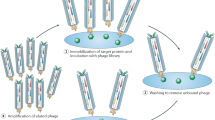Abstract
Cyclic peptides are increasingly desired for their enhanced stability and pharmacologic properties. Due to their limited conformational flexibility, cyclic peptides with C-to-N-terminal peptide bond and a disulfide bridge can confer high target binding affinity and resistance to proteolytic enzymes. Challenging drug targets including protein interaction surfaces can be successfully targeted using peptides rather than small molecules or proteins. Peptides, capable of antibody-like affinities with increased potency, can be designed to fill in the gap between small molecules and larger proteins. However, cysteine-rich peptides with several disulfide bonds have limitations in production and purification. Therefore, we devised a strategy to identify cyclic peptides with single disulfide connectivity that offers desired properties along with ease in synthesis and production. Here, de novo design of cyclic peptides is demonstrated through screening of peptide libraries using bacterial display and cell sorting. Herein, a step-by-step protocol is presented to design and screen diverse peptide libraries to identify cyclic peptides with desired specificity and affinity towards arbitrary target proteins.
Access this chapter
Tax calculation will be finalised at checkout
Purchases are for personal use only
Similar content being viewed by others
References
Robinson JA, Demarco S, Gombert F et al (2008) The design, structures and therapeutic potential of protein epitope mimetics. Drug Discov Today 13(21–22):944–951
White TR, Renzelman CM, Rand AC et al (2011) On-resin N-methylation of cyclic peptides for discovery of orally bioavailable scaffolds. Nat Chem Biol 7(11):810–817
Werle M, Kafedjiiski K, Kolmar H et al (2007) Evaluation and improvement of the properties of the novel cystine-knot microprotein McoEeTI for oral administration. Int J Pharm 332(1–2):72–79
Wong CT, Rowlands DK, Wong CH et al (2012) Orally active peptidic bradykinin B1 receptor antagonists engineered from a cyclotide scaffold for inflammatory pain treatment. Angew Chem Int Ed Engl 51(23):5620–5624
Beck JG, Chatterjee J, Laufer B et al (2012) Intestinal permeability of cyclic peptides: common key backbone motifs identified. J Am Chem Soc 134(29):12125–12133
Bock JE, Gavenonis J, Kritzer JA (2013) Getting in shape: controlling peptide bioactivity and bioavailability using conformational constraints. ACS Chem Biol 8(3):488–499
Martin SF, Clements JH (2013) Correlating structure and energetics in protein-ligand interactions: paradigms and paradoxes. Annu Rev Biochem 82:267–293
Avrutina O, Schmoldt HU, Gabrijelcic-Geiger D et al (2005) Trypsin inhibition by macrocyclic and open-chain variants of the squash inhibitor MCoTI-II. Biol Chem 386(12):1301–1306
Quimbar P, Malik U, Sommerhoff CP et al (2013) High-affinity cyclic peptide matriptase inhibitors. J Biol Chem 288(19):13885–13896
Fittler H, Avrutina O, Glotzbach B et al (2013) Combinatorial tuning of peptidic drug candidates: high-affinity matriptase inhibitors through incremental structure-guided optimization. Org Biomol Chem 11(11):1848–1857
de Veer SJ, Ukolova SS, Munro CA et al (2013) Mechanism-based selection of a potent kallikrein-related peptidase 7 inhibitor from a versatile library based on the sunflower trypsin inhibitor SFTI-1. Biopolymers 100(5):510–518
Moore SJ, Hayden Gephart MG, Bergen JM et al (2013) Engineered knottin peptide enables noninvasive optical imaging of intracranial medulloblastoma. Proc Natl Acad Sci U S A 110(36):14598–14603
Getz JA, Cheneval O, Craik DJ et al (2013) Design of a cyclotide antagonist of neuropilin-1 and -2 that potently inhibits endothelial cell migration. ACS Chem Biol 8(6):1147–1154
Rice JJ, Schohn A, Bessette PH et al (2006) Bacterial display using circularly permuted outer membrane protein OmpX yields high affinity peptide ligands. Protein Sci 15(4):825–836
Rice JJ, Daugherty PS (2008) Directed evolution of a biterminal bacterial display scaffold enhances the display of diverse peptides. Protein Eng Des Sel 21(7):435–442
Getz JA, Schoep TD, Daugherty PS (2012) Peptide discovery using bacterial display and flow cytometry. Methods Enzymol 503:75–97
Kenrick S, Rice J, Daugherty P (2007) Flow cytometric sorting of bacterial surface-displayed libraries. Curr Protoc Cytom Chapter 4:Unit4 6
Boder ET, Wittrup KD (1998) Optimal screening of surface-displayed polypeptide libraries. Biotechnol Prog 14(1):55–62
Pettersen EF, Goddard TD, Huang CC et al (2004) UCSF Chimera–a visualization system for exploratory research and analysis. J Comput Chem 25(13):1605–1612
Pierce BG, Hourai Y, Weng Z (2011) Accelerating protein docking in ZDOCK using an advanced 3D convolution library. PLoS One 6(9):e24657
Berendsen HJC, van der Spoel D, van Drunen R (1995) GROMACS: a message-passing parallel molecular dynamics implementation. Comput Phys Commun 91(1–3):43–56
Daura X, Gademann K, Jaun B et al (1999) Peptide folding: when simulation meets experiment. Angew Chem Int Ed Engl 38(1–2):236–240
Author information
Authors and Affiliations
Corresponding author
Editor information
Editors and Affiliations
Rights and permissions
Copyright information
© 2015 Springer Science+Business Media New York
About this protocol
Cite this protocol
Shivange, A.V., Daugherty, P.S. (2015). De Novo Discovery of Bioactive Cyclic Peptides Using Bacterial Display and Flow Cytometry. In: Derda, R. (eds) Peptide Libraries. Methods in Molecular Biology, vol 1248. Humana Press, New York, NY. https://doi.org/10.1007/978-1-4939-2020-4_10
Download citation
DOI: https://doi.org/10.1007/978-1-4939-2020-4_10
Published:
Publisher Name: Humana Press, New York, NY
Print ISBN: 978-1-4939-2019-8
Online ISBN: 978-1-4939-2020-4
eBook Packages: Springer Protocols




